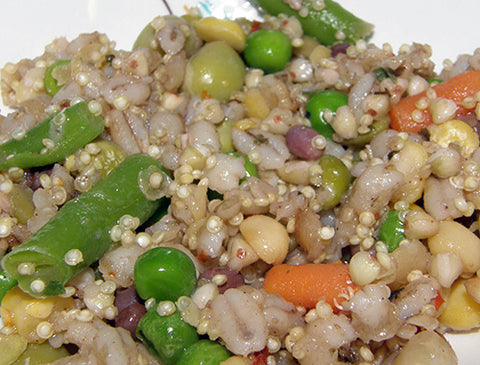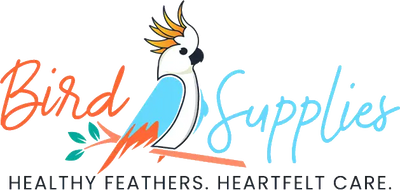Table of Contents
What Types of Bird Food Do Wild Birds Eat?

Where do Wild Parrots Get Their Food
In order to provide proper nutrition for our exotic parrots, you should find out where they get their food in the wild. Parrots are from areas near the equator. They thrive in warm, humid climates and eat the vegetation that grows in these regions. As you can expect, the vegetation in the jungles and rainforests of the world are much different that what you'll find at your local supermarket.
The vegetation that grows in these tropical regions has three main characteristics:
Parrots need their food to have little fat so that they can maintain their light body weight needed to fly miles a day.
It's not so much that you need to find the same exact foods that wild birds eat, but that you need to feed similar nutrients.
Why Do Wild Parrots Eat This Way
Birds that live in nature don’t need any "specialized diets." They eat the nutrients that their bodies actually need. As omnivores, birds are equipped with sharp beaks for cracking open seeds and tough stomachs for digesting nuts, grains, fruits, and vegetables. The question is—why do wild parrots need so many colorful foods? It isn’t for aesthetics; it’s for nutrition.
Wild parrots eat brightly colored foods for good reason. Vibrant colors indicate natural sources of beta-carotene, which is one of several nutrients that work together to maintain healthy vision. Wild parrots who are serious about their health eat foods with varying hues—not just reds, yellows, and oranges but also purples, greens, blacks, browns, and grays.
Birds don’t do color mixing; they do color matching. In nature, birds would
get sick from eating dull filler foods like white rice or yellow corn because such staples lack nutrients essential to health.
(1) Birds need nutrient dense foods, not a lot of fillers. That said, there is some controversy over avian nutritionists recommending fruits and vegetables as part of bird diets.
The truth is in how you prepare them. Unprocessed fruits and veggies are extremely high in nutrients and fiber. Cooked foods are less nutrient rich and processed foods often contain unhealthy preservatives, dyes, and synthetic unnatural nutrients.
Wild parrots eat greens year-round but will switch to foods like berries and seeds during breeding season—this gives their chicks access to different proteins that offer additional brain support as well as growth benefits.
(2) Wild parrots also seek out different insects depending on seasonal availability. In other words, you don’t need to switch your pet bird’s diet every month or even year, but it is important to keep an eye on his dietary needs—and that includes keeping him active by playing with him daily or taking him outdoors to fly around in a secure space.
When considering parrot nutrition, it’s not enough to just know what they eat in nature; we also need to examine their eating habits closer up. What we often see is that birds will fly great distances to find a diverse range of fresh, ripe foods.

How Can I Teach My Pet These Healthy Eating Habits?
The key take-away here is variety. Serve your bird a rich variety of vegetables, herbs, flowers, fruits, grains, seeds, and sprouts every day. To accomplish in a timely manner, learn to make bird chop.
If your bird won't eat fresh produce at all, watch this video.
Start making up bird chop with about 1/3 of the mix being foods that your bird is already eating. Then, slowly introduce new foods. If you are switching to fresh vegetables, start by adding a little bit of those, just to get him used to it, then increase over time.
Making Sure Commercially-Sourced Foods Are Safe.
Clean your fruits and vegetables thoroughly to remove pesticides from the skin before feeding them to your parrot. Use a bird safe vegetable cleaner or GSE to remove pesticides from the produce. You can also peel most fruits since parrots usually discard the peel any way.
Try leaving a few chunks of fruit with the peel on for the fun of it. Parrots have a natural ability to peel foods due to the unique shape of their beaks and tongues. Most parrots make a fun foraging game of shredding up fruit peel or picking at and tossing fruit seeds from fruits such as Papaya and Cantaloupe.
If there is a significant portion of the fruit or vegetable that is leftover, you can toss the unused portion in the food processor and freeze for later use.
Several things can influence whether or not your parrot eats a particular piece of produce or not. Keep the FAITH! If once you do not succeed, try, try, try again! Entice your parrot with creativity!
- Is the fruit ripened? Some parrots do prefer some fruits just before they ripen while some parrots like fruits sweet and juicy.
- Is the fruit expired or out of season? Parrots know if the fruit is good or not.
- Does your parrot avoid soiling it's beak? Your parrot might be dying to try that sweet bite of cantaloupe but he sees the juice is dripping down and he is thinking "Too messy for me!" Yes there are neat freaks out there, so we have to find a way to get parrots to try new foods.
- Flavor: Does your parrot love hot and spicy foods? Try combining dried chili peppers to cooked sweet potatoes to encourage your parrot to taste test a new healthy vegetable.
Sweet and Tangy. Does your bird love tart apples? Shred up some Granny Smith Apples and sprinkle them over another fruit you want them to try. They will love to find the surprise underneath the apples! -
Shape: Slice, Dice & Chunks. There are those little rascals who prefer their fruit or vegetables cut a certain way. Here are some tips on fitting the "cut" with your parrots persona.
- Julienne: Great for birds who use their talons to eat.
- Chunks: What else, other than for the hearty eaters.
- Diced: Ideal for those who like petite bites. Bite size pieces is also helpful in attaining less waste.
- Puree: You can also puree it in the food processor till it is a "pudding" consistency. Often times parrots will enjoy a specific produce item served warm on a spoon.
-
Shredded: Nice alternative for those who might like a certain vegetable/fruit but are afraid to try it (Try it with carrots or apples).
-
Sprout seeds for increased nutritional value to the seed junkie parrot.
- Julienne: Great for birds who use their talons to eat.
- Temperature: If your parrot does not enjoy a particular vegetable, try offering it steamed. It is an inventive way of enticing your parrot to eat specific vegetables with high nutritional values. (Note: Some parrots have an extraordinary sensitive beak which may cause them to dislike warm food. Always make sure foods are served at 105 degrees or less)
Crushed Ice Fruit Shake! Blend ice with tropical fruits such as Papaya, Mango or Pineapple.Fun Bird Recipes To Try:
- Broccoli Delite: Steam Broccoli and Carrots until tender. Sprinkle with some fresh lemon juice and serve.
- Broccoli Soup: Chop steamed Broccoli and Carrots in a food processor, add Soy Milk for and you have Cream of Broccoli soup!
- Bursting Birdie Bread: Grind up fruits and vegetables and add them to Birdie Bread!
- Fruity Oatmeal: Add a teaspoon of ground up papaya or apple to some warm oatmeal. Keep all bird food under 105 degrees. Your parrot will love to try it.
- Alcohol
- Avocado's
- Apple Seeds
- Caffeine
- Chocolate
- Dried Beans
- Mushroooms
- Onions
- Salt
- High Fat Foods
- Junk Food
- Vegetable Leaves
RELATED POSTS:
The Signs Of Malnutrition In Birds And What You Can Do About It Right Now!
Everything You Need To Know About Bird Calcium For A Happy, Healthy Bird
Diane Burroughs, LCSW is a licensed psychotherapist trained in ABA therapy techniques. She specializes in avian anxiety disorders and is certified in Nutrition For Mental Health. Diane has written a number of bird behavior books and she offers behavior consultations. She's developed a range of UnRuffledRx Science-backed Parrot Wellness Supplies.
Diane's products have been featured in the Journal of Avian Medicine and Surgery and at Exoticscon, a conference for exotic pet veterinarians. Her bird collars & supplements are stocked in avian vet clinics and bird stores throughout the US. With over 30 years in the field of behavior, Diane has created thousands of successful individualized behavior plans that help pets thrive.
TAGS: #BirdFood #RawBirdFood
SHARING IS CARING! PLEASE SHARE ON YOUR FAVORITE SOCIAL MEDIA NOW!

